When discussing high sensitivity speakers(as opposed to professional audio or PA systems), the sensitivity of speakers has traditionally been influenced by advancements in amplifier technology and performance, rather than the reverse.
In the past, extremely efficient speakers were uncommon due to limited access to substantial amounts of clean power.
This isn’t inherently positive or negative, akin to how people enjoy sports cars, turntables, or ice baths. Whether a high-efficiency speaker outperforms a lower-efficiency one depends entirely on how well its design is executed.
Today in DJ Techvibe will cover everything you need to understand about speaker sensitivity, including a roundup of the most sensitive speakers available and reviews of some affordable high-efficiency options for the average consumer.
Understanding the Contrast: Low vs. High-Sensitivity Speakers
-Low-sensitivity speakers demand greater power (watts) from the amplifier to drive them, whereas high-sensitivity speakers require less power.
-High-sensitivity speakers produce loud sound even with lower power input. For instance, a speaker with a lower sensitivity rating (88dB) needs double the power to match the volume of a higher sensitivity speaker (91dB) at the same distance.
-Additionally, high-sensitivity speakers typically come in larger sizes with spacious cabinets, whereas low-sensitivity options are more versatile in terms of placement, such as on a desk.
Both have their negative and positives; you need to match your speakers and amplifier to what functions best together, AKA’ System synergy.
For instance, if you’re rocking a 400-watt amplifier, high sensitivity speakers may not be necessary.
On the flip side, with a low-powered amplifier like a 5-watt tube amp, speakers with high SPLs are essential.
Generally speaking, I lean towards higher sensitivity speakers. They offer more headroom, minimize power loss, and excel even at lower volumes.
While higher efficiency speakers don’t necessarily outshine others in terms of sound quality, their advantage lies in being easier to drive, making them compatible with a wider range of amplifiers. On the contrary, less efficient speakers require more careful pairing with an amp to achieve optimal sound quality. This graph beautifully illustrates the concept:
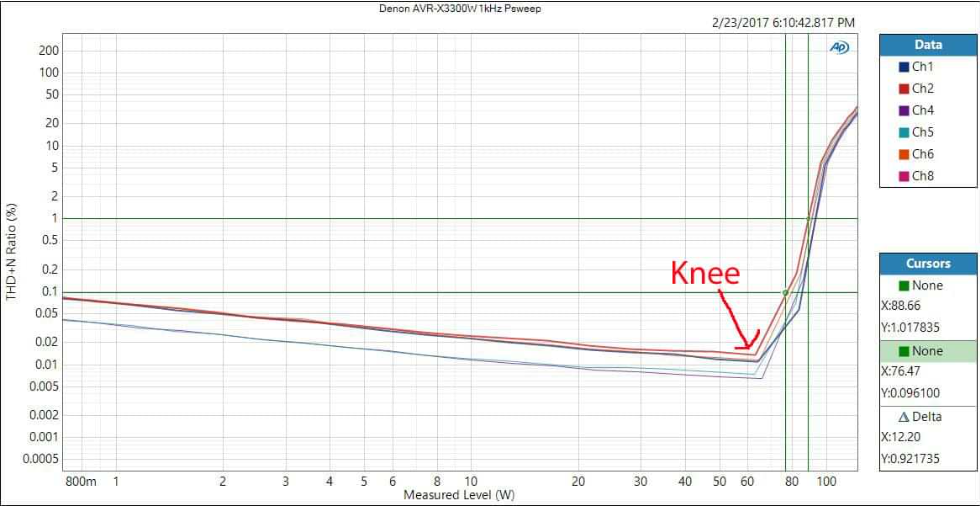
Generally, speakers vary in quality regardless of their efficiency rating. Hence, sensitivity doesn’t dictate sound quality but rather amplifier compatibility.
[For novices] Think of speaker sensitivity like MPG in cars. A car with a 29 MPG rating isn’t automatically superior to one with 21 MPG. It might not travel farther, depending on the tank size (amp). Higher MPG (efficiency) with a large tank (amp) extends the range (max SPL) but doesn’t guarantee comfort (sound quality).
Enhancing Sound on a Budget: The Power of High-Sensitivity Speakers
In general, low-sensitivity speakers paired with high-powered amps often deliver better sound quality compared to high-sensitivity speakers with lower-powered amplifiers. This is because creating a low-distortion amp with less power is easier and more cost-effective than producing a high-powered amp with low total harmonic distortion and noise.
As a result, many affordable high-sensitivity speakers sound impressive to a wide audience, as they are commonly paired with inexpensive, relatively low-powered receivers or integrated amps. Despite their modest power, these amps effectively control bass frequencies while refining midrange tones, offering enhanced detail and improved soundstage and imaging, particularly when paired with a decent DAC.
For instance, my friend achieves remarkable musicality by driving his Klipsch RP-600M speakers with the low-powered Reisong A10 tube amp. This setup not only tones down treble sharpness but also provides fatigue-free listening pleasure.
Optimizing Audio and Cinema: My High-Sensitivity Speaker Configuration
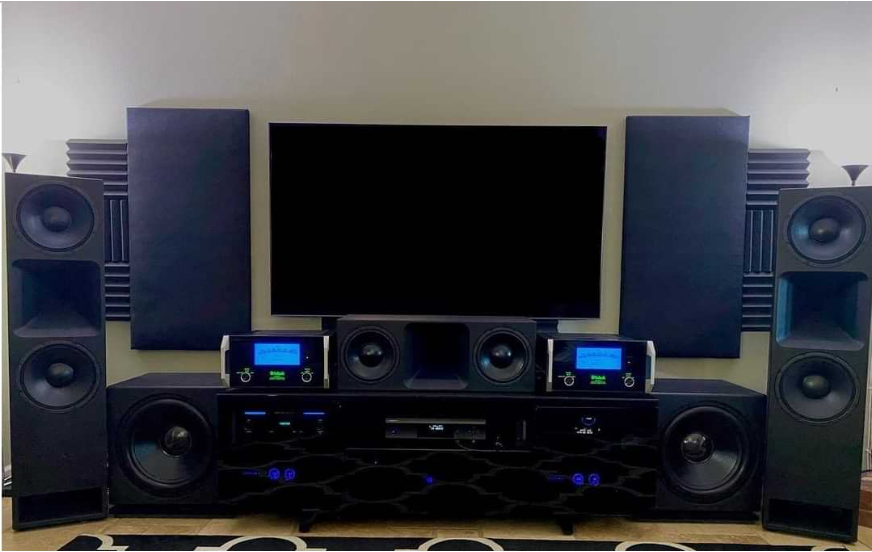
Check out my high-sensitivity setup: I’ve got the JTR 210RT speakers, boasting a 101db 1w/1m sensitivity and capable of reaching 130db output. They deliver flat response down to 30hz, only dropping 3db at 20hz in my spacious 14,000 cubic feet area.
For my source components, I’m using a Samsung TV 4K and PlayStation 5, feeding into a PS Audio DirectStream Jr. DAC for plain Tidal streaming. The audio then flows into the PS Audio M700 monoblock amps, each packing 700 watts per channel.
This configuration brings lifelike realism to stereo listening, offering endless headroom and zero bass compression regardless of volume. From essential mid-level listening sessions to movie nights with reference-level home theater sound that can shake the walls, this setup delivers. It took me over a year of research and assembly to put together, and I’m still amazed by its range and capabilities every day.
The top 5 Budget-Friendly High-Sensitivity Speakers
1. JBL Professional JRX225 3-way Loudspeaker System(100 dB @ 1w/1m)
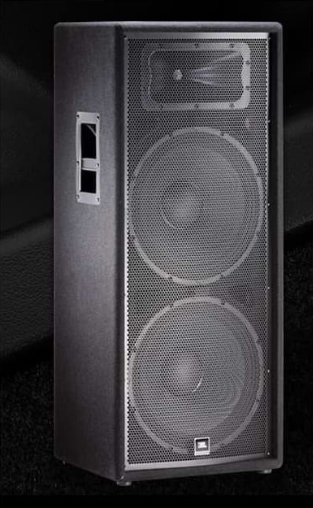
JBL markets these as ‘entry-level’ professional speakers, which might be misleading to some. Typically, ‘entry-level’ suggests lower quality, but these speakers are exceptional.
They are passive speakers, requiring a quality amplifier to drive them. Once properly tuned, the sound they produce is phenomenal.
During the month I’ve had them (I borrowed two), I’ve used them for outdoor parties with 300+ attendees and indoor events. Their sound is crisp and clear, especially with dedicated subs for outdoor use. Indoors, they provided impressive bass without additional boxes, and the top end was flawless.
For optimal impact, I recommend getting a pair. While one is sufficient, a pair offers a more balanced display. Their appearance also instills confidence in clients for performers.
However, they are heavy, so it’s advisable to have assistance when transporting them.
Overall, highly recommended for larger venues
2. Klipsch RP-8000F Floorstanding Speaker (98 dB @ 1w/1m)

As a devoted Klipsch enthusiast, my brother embarked on a journey to revamp his audio system nearly five years ago, starting with the RF82 from the first series, then transitioning to the RF7 MKII, and now opting for the RP-8000F from Klipsch’s Reference Premiere line.
Upon our first listening experience, several standout features caught our attention:
-
- Klipsch’s signature dynamics, delivering intense bass comparable to a subwoofer.
- A less aggressive roll-off compared to previous models.
- Surprisingly impressive mid-range performance, rivaling some 3-way speakers with dedicated mid-woofers.
- Exceptional performance even at high volumes, with no signs of timidityThe dual 8-inch spun-copper woofers produce deep and pure bass, while the mids and highs are remarkably clear, revealing nuances in both movies and music that were previously unnoticed.
The treble remains consistently crisp and never strident or harsh.
Optimally positioning the speakers to obscure the inner side walls from the listening area results in a three-dimensional soundstage. The 90 x 90-degree Tractrix horn contributes to a wider sweet spot, enhancing the overall spatial experience.
Furthermore, the box design exudes sophistication, and the build quality feels exceptionally premium.
With a sensitivity of 98 dB and a frequency response range of 32 Hz – 25 kHz, these speakers offer remarkable performance at a fraction of the cost of high-end brands, making them a compelling choice for audio enthusiasts seeking exceptional sound without breaking the bank.
3. QSC K12.2 Active 12″ Loudspeaker (97 dB @ 1w/1m)
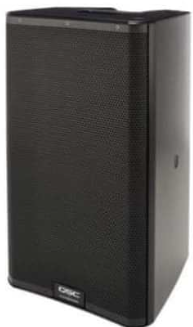
For my upcoming outdoor party series this spring, I decided to invest in two of these speakers. Last weekend, during the first event, I was a bit apprehensive about whether they would deliver the necessary volume and clarity. However, I was pleasantly surprised by their performance.
Even without subwoofers, the speakers provided ample low-end response at a significant volume. Additionally, the attendees and organizers alike were delighted with the sound quality.
The QSC K12.2 boasts a robust 2000-watt Class-D amplifier, providing ample headroom for any performance. Its built-in DSP processing further enhances sound optimization across diverse settings, ensuring seamless audio tuning for various room types.
Featuring multiple sound modes for both monitor and main usage, these speakers effortlessly elevate the performance of Sennheiser 935s microphones with minimal processing, delivering exceptional sound quality.
Renowned as industry-standard speakers, QSCs excel in corporate settings and club environments alike. Their lightweight design facilitates easy transportation on the go, with strategically placed handles for comfortable carrying.
Ideal for musicians, DJs, and event organizers alike, the QSC K12.2 is a versatile speaker solution worth serious consideration.
4. Klipsch RP-600M Bookshelf Speakers (96 dB @ 1w/1m)
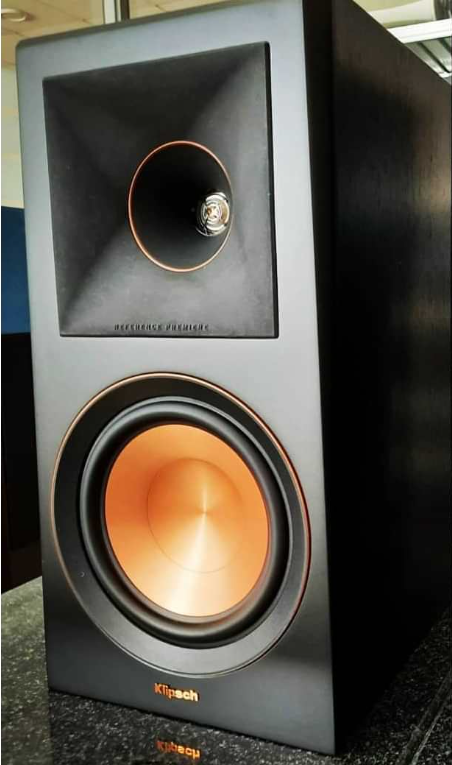
These Klipsch bookshelf speakers are a permanent fixture in my setup, adding brightness and robust bass to my basement and bedroom spaces.
Paired with a REL T/5x subwoofer, I enjoy listening at low volumes, though the sub isn’t always necessary due to the speakers’ 6.5-inch spun-copper Cerametallic woofer. However, having a subwoofer on hand enhances those moments when I crave deeper frequencies.
These speakers excel at revealing subtle details, especially when distributed across the sound stage. With their high efficiency, they don’t demand much power to drive, making them compatible with mini amps like the Fosi BT20 that I use.
For those seeking impressive sound quality at a reasonable price point, these speakers are more than sufficient. Their MDF cabinet with brushed polymer veneer finish lends them an air of sophistication, making them excellent entry-level audiophile speakers in my opinion.
While the soundstage depth may lack slightly, I’ve mitigated this with an outboard DAC, providing an enhanced listening experience for the money.
5. Wharfedale Linton High Sensitivity Bookshelf Speaker ( 90dB (2.0V @ 1m)
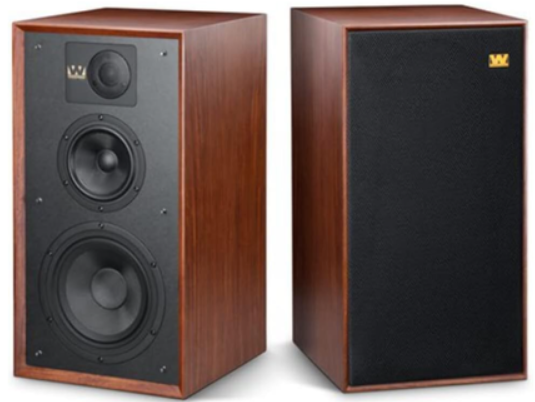
The Wharfedale Linton boasts a timeless elegance, measuring 22.2″ in height, 11.8″ in width, and 13.0″ in depth. Its design makes a bold statement in any room, although its relatively large size for a high sensitivity bookshelf speaker and may require ample space. For optimal performance, consider pairing it with the separately sold speaker stands, which are designed to complement the Linton both aesthetically and acoustically.
With a sensitivity of 90dB (2.0V @ 1m), these speakers are highly efficient, delivering clear and loud sound with minimal power. They are compatible with a wide range of amplifiers, with a recommended power range of 25-200W. This versatility ensures compatibility with various setups and user preferences.
The 8-inch subwoofer diameter is noteworthy, enhancing the speaker’s ability to produce deep and resonant bass tones, particularly important for genres requiring robust bass. Additionally, the Wharfedale Linton features waterproof capability, adding durability and versatility, suitable for environments where moisture or water exposure may be a concern.
The Pinnacle of Sensitivity: Discover the Market’s Highest Sensitivity Speakers
Experience Sonic Supremacy with the Market’s Highest Sensitivity Speakers:
Danley S.L. Jericho J3 – 116 dB @ 1w/1m Danley S.L. Jericho J6 – 114 dB @ 1w/1m
Manufactured by Danley Sound Labs, these speaker systems are engineered for professional audio applications, delivering unparalleled performance in concerts, festivals, and large-scale events. Featuring advanced driver configurations and precise horn designs, they ensure superior sound quality and directional control.
Klipsch KPT-Jubilee 535 – 108 dB @ 1w/1m Klipsch KPT-Jubilee – 108 dB @ 1w/1m
Based on the legendary Klipschorn design, the KPT-Jubilee series embodies decades of Klipsch engineering expertise. With horn-loaded components and modular flexibility, they deliver unmatched clarity and dynamic range, perfect for reproducing movie soundtracks with precision.
Meyer Sound Acheron 80 – 107 dB @ 1w/1m
The Meyer Sound Acheron series sets the standard for professional cinema loudspeakers, designed to elevate the audio experience in movie theaters and large venues. With exceptional sensitivity and precision engineering, they ensure immersive sound reproduction for audiences worldwide.
Unlock Sonic Brilliance with the Acheron 80, featuring advanced horn technology for precise sound dispersion across large listening areas, perfect for expansive movie theaters and venues prioritizing consistent sound quality. Meyer Sound’s Truextent® Beryllium compression driver technology ensures remarkable high-frequency response and minimized distortion for an unparalleled audio experience.
JBL Pro 5732 – 106 dB @ 1w/1m
The JBL Pro 5732 offers three-way loudspeaker performance with a 15-inch Differential Drive® woofer, 10-inch PolyPlas® midrange driver, and 2432H high-frequency compression driver mounted on a Progressive Transition waveguide. Built to withstand outdoor environments with its rugged multi-ply hardwood enclosure and weather-resistant finish, it’s an ideal choice for outdoor events or venues exposed to the elements.
JTR Noesis 212HT-lp– 104 dB @ 1w/1m
The JTR Noesis 212HT-lp boasts a two-way loudspeaker design with dual 12-inch woofers and a 1.4-inch compression driver mounted on a large-format horn. Its rugged multi-ply birch plywood enclosure, coated in a durable, scratch-resistant finish, ensures longevity and performance in various environments. With its low-profile design, it fits seamlessly into tight spaces without sacrificing audio quality, making it compatible with a range of digital cinema processors and audio equipment.
Sensitivity Alone Doesn’t Determine Sound Quality
While speaker sensitivity plays a role in audio performance, it’s not the sole determinant of sound quality.
Speaker sensitivity refers to a speaker’s ability to convert watts into decibels. A higher-sensitivity speaker requires less wattage to achieve a certain volume level compared to a lower-efficiency speaker. However, this difference in wattage doesn’t inherently impact audio quality.
The main implication of speaker sensitivity is that low-efficiency speakers may require more power and may need amplification beyond what’s provided by an AVR or small power source.
For instance, a Martin Logan 15A speaker may need close to 300 watts to reach 105dB without EQ or calibration, while a more efficient speaker like the JTR 210RT would require significantly less power. This might lead someone to assume that the JTR sounds better, especially when both speakers are operating on a small amplifier.
However, when both speakers are provided with ample power from a large amplifier, they can both deliver outstanding sound quality. The difference lies in power sensitivity, where a lower sensitivity speaker demands more power.
Ultimately, neither speaker sounds inherently better or worse, and both are capable of reproducing the same dynamics and vibrancy when provided with sufficient power.
High sensitivity speakers for tube amps
High sensitivity speakers are an ideal match for tube amplifiers, offering an immersive audio experience that captures the warmth and richness of analog sound reproduction.
Designed to efficiently convert electrical signals into acoustic energy, these speakers complement the nuanced dynamics and tonal characteristics of tube amps, delivering pristine sound quality across various genres and listening environments.
Whether you’re a seasoned audiophile or a discerning music enthusiast, pairing high sensitivity speakers with tube amplifiers ensures a truly captivating listening experience, characterized by exceptional clarity, depth, and fidelity.
High sensitivity car speakers
High sensitivity car speakers are engineered to deliver unparalleled audio performance in automotive environments. These speakers boast exceptional efficiency in converting electrical signals into sound, ensuring powerful and crystal-clear audio reproduction even in challenging conditions such as road noise and vehicle vibrations. Ideal for car audio enthusiasts seeking immersive sound quality on the go, high sensitivity car speakers offer dynamic range and clarity that elevate the driving experience to new heights.
Whether you’re cruising down the highway or stuck in traffic, these speakers ensure every beat and note is delivered with precision and impact
Understanding the Limitations of Sensitivity Ratings
While sensitivity ratings can be appealing for those seeking loud speakers, it’s essential to understand their limitations. These ratings are typically measured at a single frequency, often around 1000 Hz, and may not reflect the speaker’s performance across the entire frequency range.
A speaker with a high sensitivity rating may sound loud but could exhibit peaks or dips in the midrange, resulting in poor overall sound quality. Consider the analogy of a PA speaker designed solely for maximum volume in open outdoor spaces, akin to a handheld bullhorn. While these speakers excel at projecting sound over long distances, they may not deliver the nuanced sound reproduction suitable for music listening.
It’s crucial to evaluate speakers based on their overall frequency response, distortion levels, and dispersion characteristics to ensure a satisfying listening experience across various genres and applications, especially when considering high sensitivity speakers.
FAQ
What is the best sensitivity for car speakers?
If your power source is factory, opt for speakers with low RMS wattage and sensitivity over 90dB. For aftermarket stereo power, choose speakers with RMS wattage under 75 watts.
What speakers make car sound perfect?
Top-tier 2-Way Car Component Speakers: Focal ES 165 KX2 K2 Power 6-1/2″ Component Speaker System.
Supreme Car Coaxial Speakers: Focal PC 165 FE 6-1/2″ Expert Flax Evo 2-Way Coaxial Speakers.
How many watts is good for car speakers?
For optimal performance in most vehicles, speakers with a power rating ranging from 30 to 60 watts RMS (Root Mean Square) per channel are recommended. RMS denotes the speaker’s continuous power handling capacity, indicating higher RMS ratings typically yield superior sound quality and volume levels.
About the author

Karl Schuster
An esteemed figure in the DJ and technology realm, based in Berlin, Germany. Armed with extensive experience on the decks and a deep-rooted passion for innovation, Karl is a co-founder of DJ Techvibe. His visionary leadership aims to redefine the DJ equipment landscape, offering cutting-edge solutions for discerning DJs. With a wealth of expertise and an unwavering dedication to the craft.
